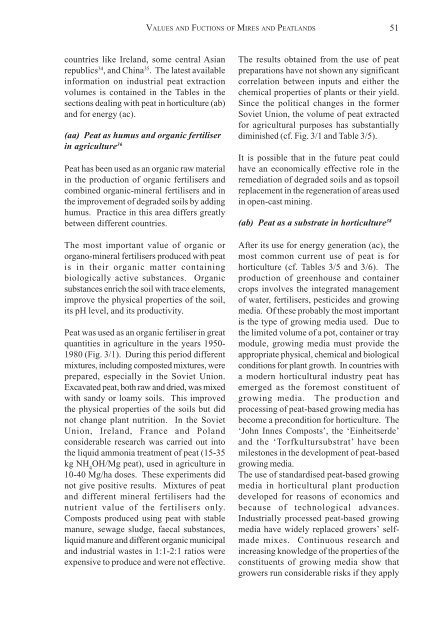wise use of mires and peatlands - Peatland Ecology Research Group
wise use of mires and peatlands - Peatland Ecology Research Group
wise use of mires and peatlands - Peatland Ecology Research Group
You also want an ePaper? Increase the reach of your titles
YUMPU automatically turns print PDFs into web optimized ePapers that Google loves.
VALUES AND FUCTIONS OF MIRES AND PEATLANDS51countries like Irel<strong>and</strong>, some central Asianrepublics 34 , <strong>and</strong> China 35 . The latest availableinformation on industrial peat extractionvolumes is contained in the Tables in thesections dealing with peat in horticulture (ab)<strong>and</strong> for energy (ac).(aa) Peat as humus <strong>and</strong> organic fertiliserin agriculture 36Peat has been <strong>use</strong>d as an organic raw materialin the production <strong>of</strong> organic fertilisers <strong>and</strong>combined organic-mineral fertilisers <strong>and</strong> inthe improvement <strong>of</strong> degraded soils by addinghumus. Practice in this area differs greatlybetween different countries.The most important value <strong>of</strong> organic ororgano-mineral fertilisers produced with peatis in their organic matter containingbiologically active substances. Organicsubstances enrich the soil with trace elements,improve the physical properties <strong>of</strong> the soil,its pH level, <strong>and</strong> its productivity.Peat was <strong>use</strong>d as an organic fertiliser in greatquantities in agriculture in the years 1950-1980 (Fig. 3/1). During this period differentmixtures, including composted mixtures, wereprepared, especially in the Soviet Union.Excavated peat, both raw <strong>and</strong> dried, was mixedwith s<strong>and</strong>y or loamy soils. This improvedthe physical properties <strong>of</strong> the soils but didnot change plant nutrition. In the SovietUnion, Irel<strong>and</strong>, France <strong>and</strong> Pol<strong>and</strong>considerable research was carried out intothe liquid ammonia treatment <strong>of</strong> peat (15-35kg NH 4OH/Mg peat), <strong>use</strong>d in agriculture in10-40 Mg/ha doses. These experiments didnot give positive results. Mixtures <strong>of</strong> peat<strong>and</strong> different mineral fertilisers had thenutrient value <strong>of</strong> the fertilisers only.Composts produced using peat with stablemanure, sewage sludge, faecal substances,liquid manure <strong>and</strong> different organic municipal<strong>and</strong> industrial wastes in 1:1-2:1 ratios wereexpensive to produce <strong>and</strong> were not effective.The results obtained from the <strong>use</strong> <strong>of</strong> peatpreparations have not shown any significantcorrelation between inputs <strong>and</strong> either thechemical properties <strong>of</strong> plants or their yield.Since the political changes in the formerSoviet Union, the volume <strong>of</strong> peat extractedfor agricultural purposes has substantiallydiminished (cf. Fig. 3/1 <strong>and</strong> Table 3/5).It is possible that in the future peat couldhave an economically effective role in theremediation <strong>of</strong> degraded soils <strong>and</strong> as topsoilreplacement in the regeneration <strong>of</strong> areas <strong>use</strong>din open-cast mining.(ab) Peat as a substrate in horticulture 38After its <strong>use</strong> for energy generation (ac), themost common current <strong>use</strong> <strong>of</strong> peat is forhorticulture (cf. Tables 3/5 <strong>and</strong> 3/6). Theproduction <strong>of</strong> greenho<strong>use</strong> <strong>and</strong> containercrops involves the integrated management<strong>of</strong> water, fertilisers, pesticides <strong>and</strong> growingmedia. Of these probably the most importantis the type <strong>of</strong> growing media <strong>use</strong>d. Due tothe limited volume <strong>of</strong> a pot, container or traymodule, growing media must provide theappropriate physical, chemical <strong>and</strong> biologicalconditions for plant growth. In countries witha modern horticultural industry peat hasemerged as the foremost constituent <strong>of</strong>growing media. The production <strong>and</strong>processing <strong>of</strong> peat-based growing media hasbecome a precondition for horticulture. The‘John Innes Composts’, the ‘Einheitserde’<strong>and</strong> the ‘Torfkultursubstrat’ have beenmilestones in the development <strong>of</strong> peat-basedgrowing media.The <strong>use</strong> <strong>of</strong> st<strong>and</strong>ardised peat-based growingmedia in horticultural plant productiondeveloped for reasons <strong>of</strong> economics <strong>and</strong>beca<strong>use</strong> <strong>of</strong> technological advances.Industrially processed peat-based growingmedia have widely replaced growers’ selfmademixes. Continuous research <strong>and</strong>increasing knowledge <strong>of</strong> the properties <strong>of</strong> theconstituents <strong>of</strong> growing media show thatgrowers run considerable risks if they apply
















